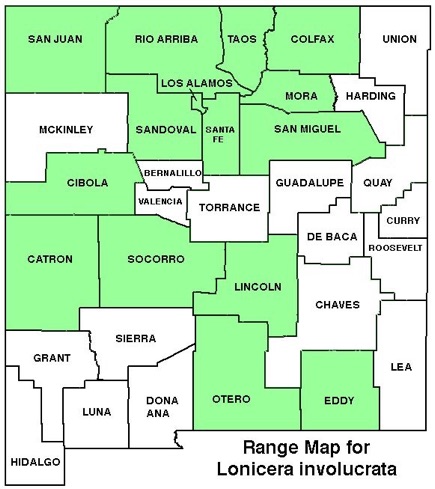WILDFLOWERS OF NEW MEXICO

Reaching 2–6 feet tall with 4-angled twigs, this leafy, intricately branched shrub has paired tubular yellow flowers and opposite leaves. Note the green turning reddish, leaf-like bracts that surround the flowers and later the twin black berries.
FLOWERS: June–September. Paired flowers from leaf axils with 2 pairs of large, fused, leaf-like bracts with glandular hairs; floral tube 3/8–3/4 inch long (1–2 cm), with 5 small lobes slightly flaring open; outer surface densely glandular-hairy. Fruit paired, shinny black berries, 1/4–3/8 inch diameter (6–10 mm), bracts leaf-like, reddish-purple, glandular hairy.
LEAVES: Opposite on short, hairy stalks (petioles). Blades elliptic to oblong, 1 1/2–6 inches long (4–15 cm) by 1/4 inch wide (7 mm); edges lined with ciliate hairs; top surfaces smooth, bottoms sparsely stiff-hairy, tips pointed.
HABITAT: Moist woodlands, meadows, stream sides; pinyon-juniper foothills, ponderosa-Douglas fir, spruce-fir forests.
ELEVATION: 7,400–11,500 feet (2255–3505 m).
RANGE: Rocky Mts. and all states westward; Canada.
SIMILAR SPECIES: Other native honeysuckle species have red, white, or creamy flowers and red berries.
NM COUNTIES: Widespread, common in mid- to high-elevation, moist habitats: Catron, Cibola, Colfax, Eddy, Lincoln, Los Alamos, Mora, Otero, Rio Arriba, San Juan, San Miguel, Sandoval, Santa Fe, Socorro, Taos.









TWINBERRY HONEYSYCKLE
LONICERA INVOLUCRATA
Honeysuckle Family, Caprifoliaceae
Deciduous shrub



























THE CONTENTS OF THIS WEBSITE ARE COPYRIGHTED AND CANNOT BE USED
WITHOUT PERMISSION OF GEORGE OXFORD MILLER
















EMAIL ME




































Red Leaf-like bracts cup the ripe black fruit.
Flowers and fruit grow in pairs on short, hairy stems.
Large leaves grow in pairs with twin flowers and fruit in the leaf axils.
Twinberry honeysuckle occurs in moist mountain forests and along water.
















